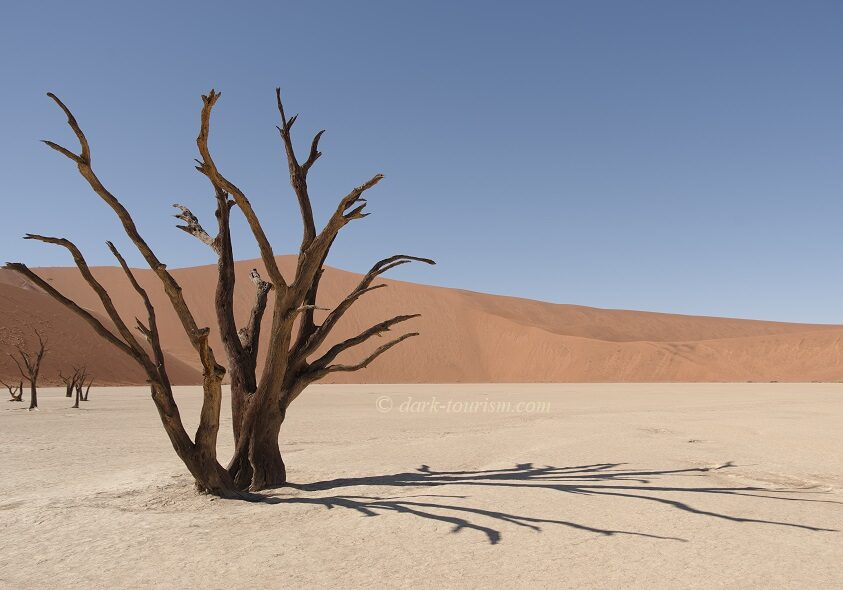| |
|
| ||
|
| |
Namibia, Headline-Making Deaths and More or Less Forgotten Wars Hello subscribers – and welcome new ones! Last week I finally uploaded the first of a series of posts about my recent trip to Namibia. It’s a rather kaleidoscopic overview of various more or less dark aspects that popped up here and there during that trip, as well as about places I had specifically planned to visit for their dark histories. This included e.g. Shark Island, site of an infamous early concentration camp during the German colonial forces’ campaign against the rebelling Herero and Nama peoples in 1904-07 – generally regarded as the first genocide of the twentieth century. (See this chapter summarizing Namibian history for more background.) Also featured in the new Namibia post are some photos of various shipwrecks and of the country’s characteristic harsh desert landscapes along with photos of some of the venomous or carnivorous animals inhabiting these lands. Out of Namibia’s flora and fauna the most iconic images show the lifeless trees at Dead Vlei near Sossusvlei in the heart of the Namib-Naukluft National Park. The photo above is an example of the fine photographic opportunities to be had at that magical place. Moreover, Dead Vlei is framed by some of the highest sand dunes in the world, towering up to 350m high. Do take a look at this new post! Namibia’s main type of dark-tourism attraction, however, comes in the form of ghost towns. I explored several during this recent trip, including the fabled Kolmanskop, as briefly featured in the previous Newsletter, but also a couple of far less well-known and much, much less visited ones that were also extremely photogenic. These will be given separate stand-alone blog posts over the coming weeks/months. And then I will have to write a whole series of new chapters for my main website as well. What else? The weeks since my latest DT Newsletter have seen the deaths of some prominent figures, not only that of the UK’s Queen Elizabeth II, currently dominating the news in Britain and beyond, but also before her that of the last leader of the Soviet Union, Mikhail Gorbachev. Both of these figures’ passing marks the end of an era. The other main topic that continues to dominate the media is of course the ongoing war in Ukraine (or ‘special military operation’ in official Russian Newspeak). It so happened that a reader of my website recently contacted me about actually travelling to Kyiv and some of the formerly Russian-occupied places near the city, including the by now infamous Bucha and Irpin. I couldn’t provide much practical advice but he managed to get there and find a guide to take him around those places himself. This reader just sent me a link to an album of photos he took there – here’s the link for you to have a look yourself … but be warned, some images of the recent war damage are quite shocking. Also included are photos taken at Kyiv’s war museum, which has already begun integrating sections about this ongoing conflict. This is probably travel on the very edge of the concept of dark tourism. I would personally not recommend travelling to actual war zones (with ongoing battle action, I mean). But as far as Kyiv and its surroundings are concerned, these can now be considered recent war zones, no longer under acute direct threat. And the people this traveller met have apparently been welcoming, also with regard to photography, so I was told – the reported attitude being: the more people abroad get to see in terms of documentation of the current plight of Ukraine, the better … But the Ukraine conflict is not the only one raging? in these troubled times. In the Caucasus, clashes between Azerbaijan and Armenia over the disputed territory of Nagorno-Karabakh have recently been flaring up again, throwing into doubt whether the Russia-brokered ceasefire deal of late 2020 can hold. I’m glad I travelled to the region when I did. Getting to Nagorno-Karabakh now would be all but impossible. And in Ethiopia, where I was in December 2019/January 2020, the civil war-like conflict that has since broken out between the people of the northern province of Tigray and government forces (as repeatedly reported on my DT Blog – the latest was this post) is continuing too – and as a consequence hundreds of thousands if not millions of civilians are currently threatened with famine. Just because the Western media concentrate on death and war in Europe at this time doesn’t mean those tragedies and humanitarian catastrophes further from us have gone away. These continue to be very dark times. But the newest DT Blog Post can in part serve as a bit of respite – as did much of my trip to Namibia for myself. Being cut off from the Internet and mobile phone coverage at some of the more remote locations I visited was in fact quite relaxing and provided for a dose of “escapism” in its own way. It really was quite a wonderful trip, despite the various very dark aspects of mostly early twentieth century history. I especially miss the almost uninhabited, quiet and wide-open stillness of the Namibian desert scenery. The photo above is just one little taster … And with that I’m signing off for this time. Best wishes, Peter |
|
| |
|
| |||
|
